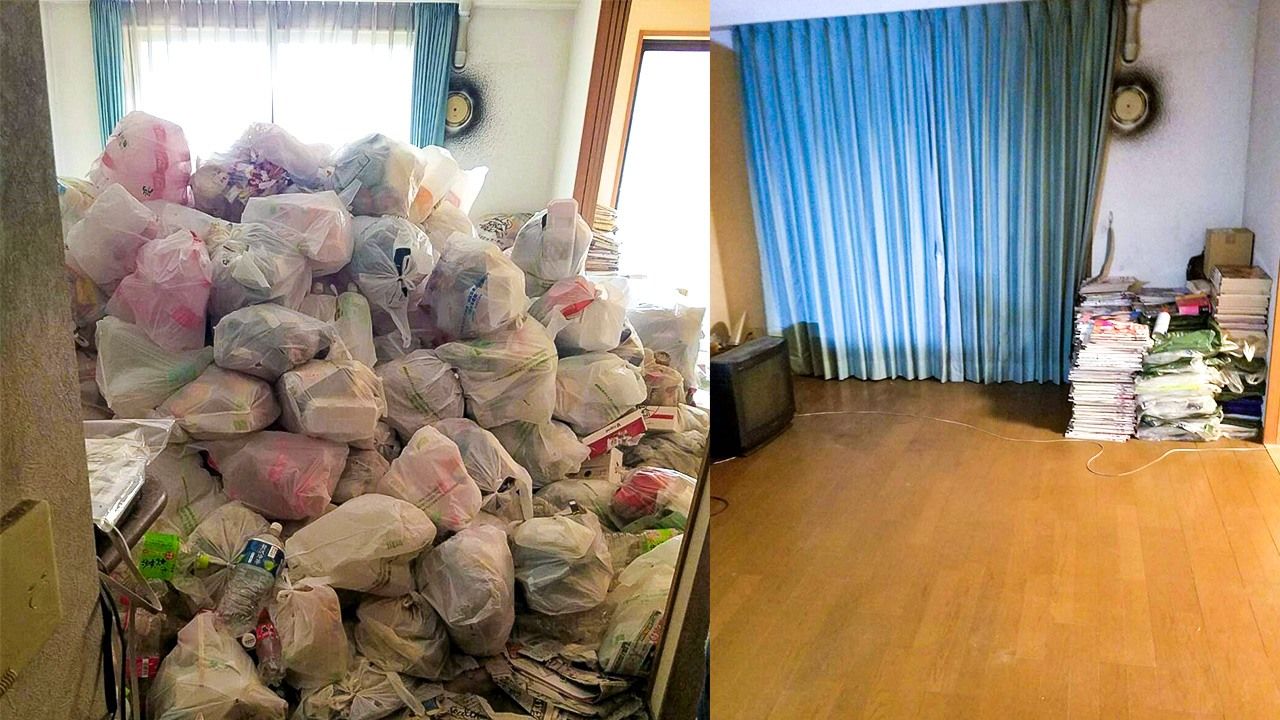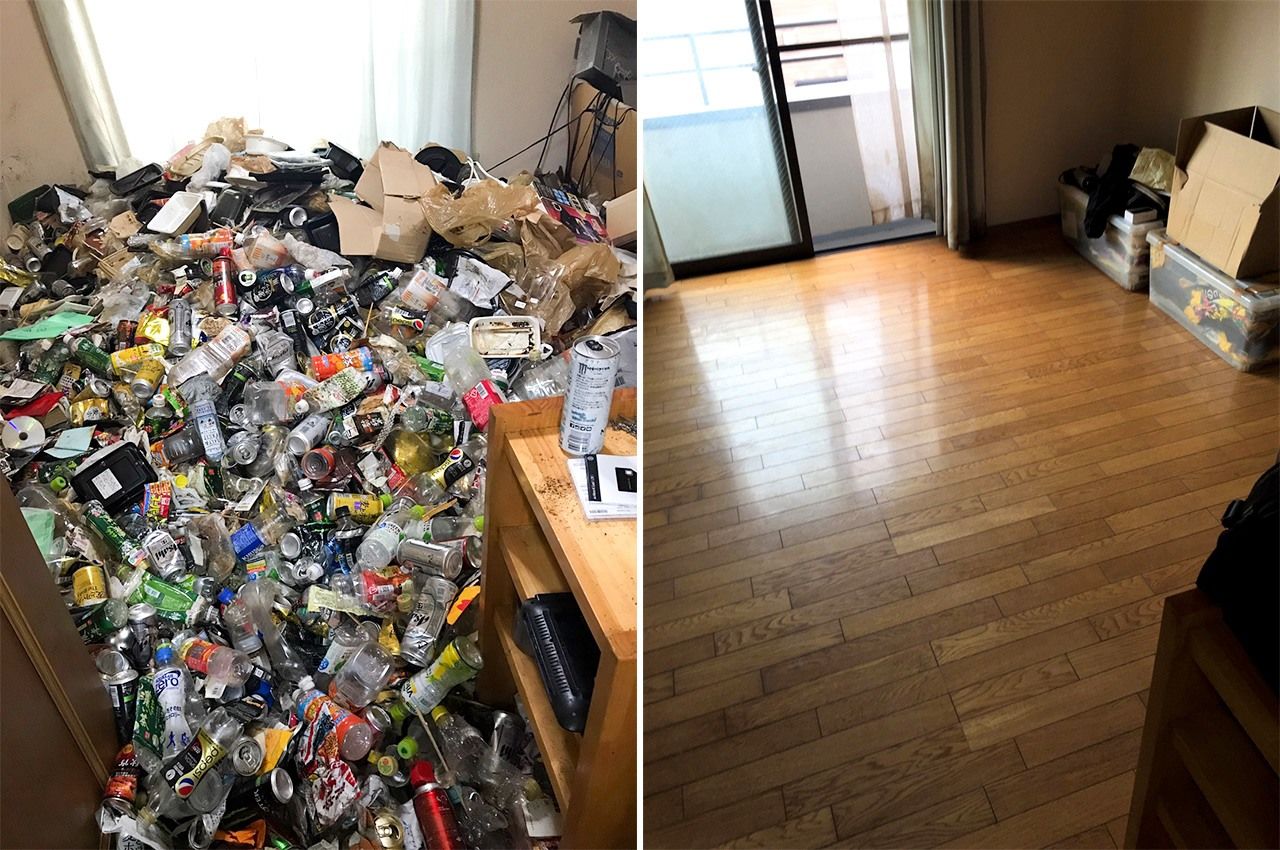
No “Spark of Joy” for People Living in Trash Houses
Society Lifestyle- English
- 日本語
- 简体字
- 繁體字
- Français
- Español
- العربية
- Русский
Minimalists who find joy in possessing only the absolute essentials of life represent the latest trend following that of the popular Konmari and danshari movements for discarding what you no longer need and neatly organizing what remains. Yet, though there are those who find pleasure in keeping things tidy, the reality in Japan is that there are also hoarders living in piles of garbage because they just cannot throw anything away.
“In these peoples’ homes,” says Sasaki Hisashi, “you find leftover food, discarded instant-noodle cups, and half-filled drink containers. For some, the garbage is piled so high, they can’t open their toilet door and instead pee into a bottle. My business is cleaning up these ‘trash houses.’ Sasaki’s company, Magonote Inc., averages around 850 houses a year.
Suicidal Thoughts Lead to a New Career
For Sasaki, this line of work goes back to 2008, when his trucking business in Osaka went bankrupt. “I made my way to Tokyo and started taking on odd jobs as a handyman. Lofty ideals of serving society and helping people in distress were the last things on my mind. I’d do anything if it brought in some cash.”
One day, a student at a prestigious university hired Sasaki to clean her apartment. He recalls: “I visited her place to give her an estimate, but nearly turned around and left. Upon opening the door, I was accosted by the sight of a huge pile of garbage a full meter high leading from the entrance all the way back into her typically small student apartment. There was a foul odor and flies buzzed about. The gas and electricity had been turned off. This girl was living in the middle of this garbage with only a flashlight to find her way around. I had done some housecleaning and garbage disposal jobs before, but this was my first encounter with a bona fide trash house.”
The young woman was living on an allowance sent to her by her parents and could not pay very much. Sasaki, meanwhile, had only just started his handyman business a year ago, and was in no position to take on charity work. But something drew him to the job. “This young girl was only around twenty or so, and here she was, living in a garbage dump. I just couldn’t turn her down out of hand. Finally, we agreed she would pay the remainder of what she owed in installments later. I had no idea how to go about cleaning a trash house and there were no employees to help me, just my wife and son. The three of us set about the task with grim determination.”
It wasn’t until later, when the student sent me an email of thanks, that Sasaki truly finally felt like he had done the right thing. “Others had turned her down, she wrote, and if I had also rejected the job, she thought she would have to kill herself. That’s when I made the decision to specialize in this kind of work.”
Old People Clinging to Old Things
Generally, people want to make a good impression when friends come to visit or spend the night. They will rarely allow things to get into such disarray. The people who trash their homes are the ones who have difficulty communicating with others. They simply stop caring because, after all, no one is going to visit them.
Yet not a few of the requests for a major clean-up come from highly educated top-earners, people well-established in society. A number of nurses, for example—particularly those who work in emergency outpatient services and intensive care units—fall into this category, says Sasaki. “They deal every day with life-and-death matters and are skilled communicators, but off the job they live in garbage-filled trash houses. This isn’t because they are lazy, but more likely because it is the only way they can balance out the tension of their demanding work.
“One day, though, it dawns on them that they need help, and I get a call. Most of my clients remember whatever it may have been that got them started living this way, but they seldom remember the process by which the garbage accumulated. They climb and walk over steep piles of garbage almost as high as the ceiling and sleep on that garbage without a thought. It’s just insane.”
And then there are the old people, he notes—the ones in their seventies and older who lived through years of having nothing. They find it painful to throw anything away. They hang on to old bedding, frayed clothing, and out-of-style dishes from decades ago because they “might” use them again someday. All of this stuff piles up and suddenly they are overwhelmed.
“Given what I’ve seen, I think the elderly should be allowed to keep their things, even if you know they will never use them, so long as their homes are relatively sanitary and at least navigable. It may sound crass, but frankly, the cleaning up can be done after they die. That’s a lesson I learned from one of my clients.”

Before and after views of a trash house. (© Magonote Inc.)
This client, recalls Sasaki, was an academic in her forties who had been living alone but was going to move into a larger condominium with her aging parents. Her parents used to own a secondhand bookstore and they loved books. After they closed their store, they rented an apartment just to house all of them.
“My client wanted to make sure her parents could keep their precious collection. She rented a three-bedroom condo and filled two of the rooms with their books. She told me: ‘They’re seeing their friends die one after another. Their bodies are falling apart, and their memories are fading. They are losing so much, I am not going to take away anything more from them.’”
She made me realize something important: Cleaning up doesn’t mean simply throwing everything away.
A Byproduct of Urban Isolation
The Tokyo metropolitan area is packed with apartments and condominiums. These are the kinds of places Sasaki’s company is asked to clean. As he notes, It is quite common for people to be oblivious to the trash house just one wall away from their own apartment. In fact, a lot of people don’t even know their neighbors’ names; they simply ignore the comings and goings of those around them.
But this ignorance can’t last forever. “It usually begins with complaints to the management about foul odors. But there are legal restrictions that prevent stepping into someone else’s home right away. While everyone diddles and dawdles, things just get worse. Finally, we are called in, but even though we are hauling out loads of trash the neighbors totally ignore us. There can be people all around us, and yet it feels like we’re working on a deserted island.”
Not so long ago, says Sasaki, in a standard Japanese community there would have been a well-intentioned busybody neighbor reminding you to take out your garbage and knocking on your door to tell you to “do something about that smell!” These days, however, people want to avoid trouble, and ignoring your neighbors is considered the right thing to do. But that lack of human interaction is one of the factors leading to the appearance of trash houses.
The Doom of the Disposable Lifestyle
Another factor is that people have gotten used to a throw-away lifestyle. A deflating economy over the past three decades has heightened the popularity of cheap products like those sold at ¥100 shops and clothing from so-called fast fashion lines and low-priced online shops. A lot of people with relatively high incomes fill their homes with the cheapest things.
“A few years ago,” recalls Sasaki, “we found a huge collection of 300-yen umbrellas in a client’s home. There were also a lot of cheap-looking neckties and fake brand watches. I told that client, you need to be brave. Go out and buy an umbrella that costs at least 15,000 yen, suits that cost more than 50,000 yen, and real, quality brand watches.”
When an umbrella costs only ¥300, we are going to forget it at the last bar we went to and think nothing of buying another at a convenience store. But if the umbrella costs ¥15,000, we aren’t going to want to go back to using the cheap vinyl versions, and we will be less likely to leave it someplace. “If you wear a watch that cost you a million yen, you sure aren’t going to take it off and just plop it someplace when you get home. You keep it well-maintained and use it with care,” says Sasaki.
That particular client, he recalls, spent a full year replacing his possessions little by little. His whole lifestyle changed, and he was able to get a good job with a better salary.
“Sometimes I think if there were no convenience stores, 100-yen shops, or online shopping, my trash house cleaning work would no longer be a viable business. The habitual buying of cheap things devalues a person’s humanity.”
Cleaning Your House to Clean Up Your Life
So what prompts people to call for Sasaki’s service? “Some of them tell us that they just got transferred to a new office and have to clean the apartment in order to move out, or that there’s going to be a gas inspection. But the habits that lead to a trash house can’t be done away with passively, by some external event like this. You have got to realize there’s something deeply wrong with your life and act on that realization.”
Sasaki stresses that the cleaners must not tell the client to go out for the day while they clean. “Our company requires the client to participate in the process. Watching the rooms in your home reappearing as the trash is hauled out is like turning back time. Our hope is that this will keep our clients from trashing their home again just a few months later.”
It can be hard work, he admits, cleaning out a place full of maggots and stinking of feces and urine. “A lot of the people we hire quit after just a few days. Still, there are rewards, like having a young university student rethink her suicidal thoughts or turning around a person’s life simply by helping them clean out their trash. The thrill of our work is that it links us to the drama of human life.” Without that thrill and satisfaction, says Sasaki, this is the kind of work only a dedicated ascetic monk could do. Ï truly believe that cleaning up your home is a way to clean up your life.”
(Originally published in Japanese. Reporting and editing by Nippon.com. Banner photo: Before and after photos of a trash house. © Magonote Inc.)
